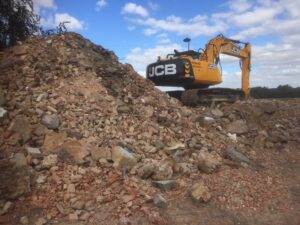The composition of rubble aggregates must not contain elements that may impair their use in terms of their nature, size, shape and content. Examples include clay lumps, coal, lignite, coke, soluble or insoluble salts, black coal shale, refractory rock, and so on.
Crushed concrete rubble composition:
1. The percentage of broken concrete rubble and broken natural stony material exceeds 90%.
2. The percentage of masonry rubble type material is less than 10%.
3. The percentage of other stony material is less than 5%.
4. The percentage of hydrocarbon mixtures is less than 5%.
5. The percentage of non-stony material is less than 1%.
6. The percentage of organic matter is less than 0.5%.


Composition crushed mixed rubble:
1. The percentage of broken concrete rubble and broken natural stony material exceeds 40%.
2. The percentage of masonry rubble type material exceeds 10%.
3. The percentage of other stony material is less than 10%.
4. The content of hydrocarbon mixtures is less than 5%.
5. Non-stony material content is less than 1%.
6. The organic matter content is less than 0.5%.
Composition of crushed asphalt rubble:
1. The content of crushed concrete rubble and crushed natural stony material is less than 30%.
2. There is no content of masonry rubble type material [m%].
3. There is no content of other stony material [m%].
4. Hydrocarbon mixture content [m%] exceeds 70%.
5. Content of non-stony material is less than 1%.
6. Organic matter content is less than 0.5%.
Composition of crushed concrete and asphalt rubble:
1. Content of crushed concrete rubble and crushed natural stony material is more than 55%.
2. Content of masonry rubble is less than 10%.
3. Content of other stony material is less than 5%.
4. Hydrocarbon mixture content is less than 30%.
5. Non-stony material content is less than 0.5%.
6. Organic matter content is less than 0.5%.



